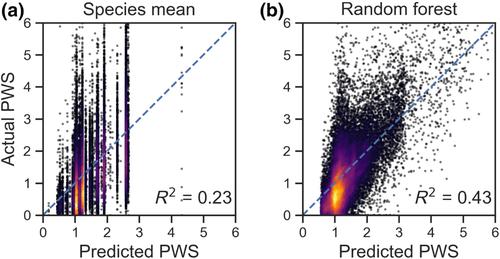当前位置:
X-MOL 学术
›
Glob. Change Biol.
›
论文详情
Our official English website, www.x-mol.net, welcomes your
feedback! (Note: you will need to create a separate account there.)
Tree species explain only half of explained spatial variability in plant water sensitivity
Global Change Biology ( IF 10.8 ) Pub Date : 2024-07-15 , DOI: 10.1111/gcb.17425 Alexandra G Konings 1 , Krishna Rao 1, 2 , Erica L McCormick 1 , Anna T Trugman 3 , A Park Williams 4 , Noah S Diffenbaugh 1 , Marta Yebra 5, 6 , Meng Zhao 7
Global Change Biology ( IF 10.8 ) Pub Date : 2024-07-15 , DOI: 10.1111/gcb.17425 Alexandra G Konings 1 , Krishna Rao 1, 2 , Erica L McCormick 1 , Anna T Trugman 3 , A Park Williams 4 , Noah S Diffenbaugh 1 , Marta Yebra 5, 6 , Meng Zhao 7
Affiliation

|
Spatiotemporal patterns of plant water uptake, loss, and storage exert a first‐order control on photosynthesis and evapotranspiration. Many studies of plant responses to water stress have focused on differences between species because of their different stomatal closure, xylem conductance, and root traits. However, several other ecohydrological factors are also relevant, including soil hydraulics, topographically driven redistribution of water, plant adaptation to local climatic variations, and changes in vegetation density. Here, we seek to understand the relative importance of the dominant species for regional‐scale variations in woody plant responses to water stress. We map plant water sensitivity (PWS) based on the response of remotely sensed live fuel moisture content to variations in hydrometeorology using an auto‐regressive model. Live fuel moisture content dynamics are informative of PWS because they directly reflect vegetation water content and therefore patterns of plant water uptake and evapotranspiration. The PWS is studied using 21,455 wooded locations containing U.S. Forest Service Forest Inventory and Analysis plots across the western United States, where species cover is known and where a single species is locally dominant. Using a species‐specific mean PWS value explains 23% of observed PWS variability. By contrast, a random forest driven by mean vegetation density, mean climate, soil properties, and topographic descriptors explains 43% of observed PWS variability. Thus, the dominant species explains only 53% (23% compared to 43%) of explainable variations in PWS. Mean climate and mean NDVI also exert significant influence on PWS. Our results suggest that studies of differences between species should explicitly consider the environments (climate, soil, topography) in which observations for each species are made, and whether those environments are representative of the entire species range.
中文翻译:

树种只能解释植物水敏感性空间变异的一半
植物水分吸收、损失和储存的时空模式对光合作用和蒸散量具有一级控制作用。许多植物对水分胁迫反应的研究都集中在物种之间的差异,因为它们的气孔闭合、木质部导度和根性状不同。然而,其他几个生态水文因素也相关,包括土壤水力学、地形驱动的水的重新分配、植物对当地气候变化的适应以及植被密度的变化。在这里,我们试图了解优势物种对于木本植物对水分胁迫反应的区域尺度变化的相对重要性。我们使用自回归模型根据遥感实时燃料水分含量对水文气象变化的响应来绘制植物水敏感性(PWS)。活燃料含水量动态可为 PWS 提供信息,因为它们直接反映植被含水量,从而反映植物吸水和蒸散的模式。 PWS 的研究使用了 21,455 个树木繁茂的地点,其中包含美国西部地区的美国林务局森林清查和分析图,这些地点的物种覆盖情况是已知的,并且单一物种在当地占主导地位。使用特定于物种的平均 PWS 值可以解释 23% 的观察到的 PWS 变异性。相比之下,由平均植被密度、平均气候、土壤特性和地形描述符驱动的随机森林解释了观察到的 PWS 变异的 43%。因此,优势物种只能解释 53%(23% 与 43%)的 PWS 可解释变异。平均气候和平均NDVI也对PWS产生显着影响。 我们的结果表明,对物种之间差异的研究应明确考虑对每个物种进行观察的环境(气候、土壤、地形),以及这些环境是否代表整个物种范围。
更新日期:2024-07-15
中文翻译:

树种只能解释植物水敏感性空间变异的一半
植物水分吸收、损失和储存的时空模式对光合作用和蒸散量具有一级控制作用。许多植物对水分胁迫反应的研究都集中在物种之间的差异,因为它们的气孔闭合、木质部导度和根性状不同。然而,其他几个生态水文因素也相关,包括土壤水力学、地形驱动的水的重新分配、植物对当地气候变化的适应以及植被密度的变化。在这里,我们试图了解优势物种对于木本植物对水分胁迫反应的区域尺度变化的相对重要性。我们使用自回归模型根据遥感实时燃料水分含量对水文气象变化的响应来绘制植物水敏感性(PWS)。活燃料含水量动态可为 PWS 提供信息,因为它们直接反映植被含水量,从而反映植物吸水和蒸散的模式。 PWS 的研究使用了 21,455 个树木繁茂的地点,其中包含美国西部地区的美国林务局森林清查和分析图,这些地点的物种覆盖情况是已知的,并且单一物种在当地占主导地位。使用特定于物种的平均 PWS 值可以解释 23% 的观察到的 PWS 变异性。相比之下,由平均植被密度、平均气候、土壤特性和地形描述符驱动的随机森林解释了观察到的 PWS 变异的 43%。因此,优势物种只能解释 53%(23% 与 43%)的 PWS 可解释变异。平均气候和平均NDVI也对PWS产生显着影响。 我们的结果表明,对物种之间差异的研究应明确考虑对每个物种进行观察的环境(气候、土壤、地形),以及这些环境是否代表整个物种范围。

































 京公网安备 11010802027423号
京公网安备 11010802027423号